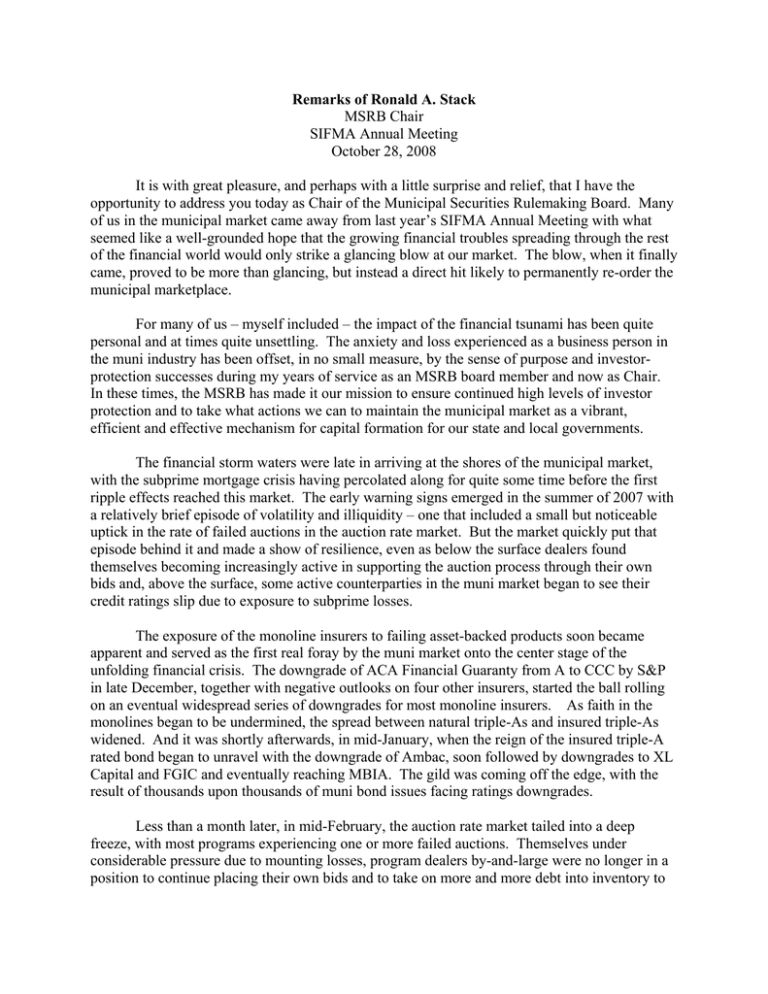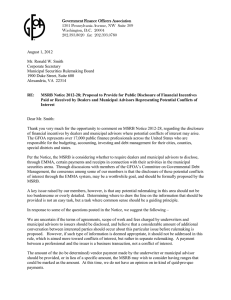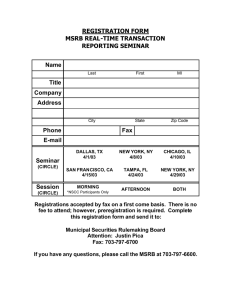Remarks of Ronald A. Stack MSRB Chair SIFMA Annual Meeting October 28, 2008
advertisement

Remarks of Ronald A. Stack MSRB Chair SIFMA Annual Meeting October 28, 2008 It is with great pleasure, and perhaps with a little surprise and relief, that I have the opportunity to address you today as Chair of the Municipal Securities Rulemaking Board. Many of us in the municipal market came away from last year’s SIFMA Annual Meeting with what seemed like a well-grounded hope that the growing financial troubles spreading through the rest of the financial world would only strike a glancing blow at our market. The blow, when it finally came, proved to be more than glancing, but instead a direct hit likely to permanently re-order the municipal marketplace. For many of us – myself included – the impact of the financial tsunami has been quite personal and at times quite unsettling. The anxiety and loss experienced as a business person in the muni industry has been offset, in no small measure, by the sense of purpose and investorprotection successes during my years of service as an MSRB board member and now as Chair. In these times, the MSRB has made it our mission to ensure continued high levels of investor protection and to take what actions we can to maintain the municipal market as a vibrant, efficient and effective mechanism for capital formation for our state and local governments. The financial storm waters were late in arriving at the shores of the municipal market, with the subprime mortgage crisis having percolated along for quite some time before the first ripple effects reached this market. The early warning signs emerged in the summer of 2007 with a relatively brief episode of volatility and illiquidity – one that included a small but noticeable uptick in the rate of failed auctions in the auction rate market. But the market quickly put that episode behind it and made a show of resilience, even as below the surface dealers found themselves becoming increasingly active in supporting the auction process through their own bids and, above the surface, some active counterparties in the muni market began to see their credit ratings slip due to exposure to subprime losses. The exposure of the monoline insurers to failing asset-backed products soon became apparent and served as the first real foray by the muni market onto the center stage of the unfolding financial crisis. The downgrade of ACA Financial Guaranty from A to CCC by S&P in late December, together with negative outlooks on four other insurers, started the ball rolling on an eventual widespread series of downgrades for most monoline insurers. As faith in the monolines began to be undermined, the spread between natural triple-As and insured triple-As widened. And it was shortly afterwards, in mid-January, when the reign of the insured triple-A rated bond began to unravel with the downgrade of Ambac, soon followed by downgrades to XL Capital and FGIC and eventually reaching MBIA. The gild was coming off the edge, with the result of thousands upon thousands of muni bond issues facing ratings downgrades. Less than a month later, in mid-February, the auction rate market tailed into a deep freeze, with most programs experiencing one or more failed auctions. Themselves under considerable pressure due to mounting losses, program dealers by-and-large were no longer in a position to continue placing their own bids and to take on more and more debt into inventory to -2avoid failed auctions. As auctions began to fail in large numbers, many issuers faced sharp increases in borrowing costs and investors suddenly found themselves holding now illiquid securities that, until then, had generally been as liquid as cash. Although many investors might find solace in higher fail rates paid on their auction rate securities in return for this new-found illiquidity, other investors were doubly impacted when they discovered that the fail rate for their particular auction rate securities proved to be unusually low. Issuers faced with high fail rates and unhappy investors sought to take quick action, with many issuers moving toward refinancing out of their auction rate debt – either through remarketings or refundings. Others began placing bids on their own debt under no-action relief provided by the SEC and related tax relief issued by the IRS. The focus didn’t stay solely on the auction rate market break for very long, though. Bear Stearns’ collapse and federally-backed acquisition by JP Morgan in March brought home the dire danger of the rapidly expanding storm. Yet, for a time, the action taken to avoid the uncontrolled liquidation of Bear was viewed by many as a potential pivot point away from further market turmoil. In the meantime, the auction rate market continued the painstaking process of working its way out of its paralysis, program-by-program, with a flood of issuers seeking new liquidity facilities to back the move out of auction rates into VRDOs – this at the same time as the broader financial markets were experiencing a retrenchment away from taking on new credit commitments. Just as the muni market’s need for access to stable, large scale liquidity support was peaking, the supply of such support was contracting dramatically. When it was available, the commitments that were offered were for shorter and shorter terms at a price that continued to move upwards. And, over time, the banks offering liquidity to issuers began finding themselves the holders of last resort of unremarketed inventory as investors shied away from the short-term market, at any price. This growing inventory of bank bonds was creating – and continues to be – a significant clog on the short-term market, raising interest costs to issuers and tying up bank resources with a result that more and more potential sources of liquidity were being forced to the sidelines. The downward spiral of the broader financial market, after a brief pause following the Bear Stearns collapse, also began to re-accelerate, further limiting access by the muni market to much needed liquidity and short-term credit. In sum, the short-term market was approaching complete shut down. The play card in the muni market also continues to morph. UBS pulled out of the municipal market; Lehman Brothers – my own shop – fell into bankruptcy and disappeared from the scene; Merrill Lynch agreed to be acquired by Bank of America; Goldman Sachs and Morgan Stanley became banks. The era of the large independent New York investment banks had come to a dizzying close. We have entered a new era, still very much in its formative stages, where the commercial banks represent the large money-centers, the regional or super-regional broker-dealers are now finding space in which to potentially reclaim a larger share of the muni marketplace, and new entrants – including my own new home, Barclays – inject fresh blood into the market. And these banks and the financial system are not your grandfather’s old banks and system, as each week seems to bring new facilities, new programs, new ownership structures – including direct federal -3investment in banks – introduced to stabilize and turn-around the financial markets. Or maybe your grandfather might just recognize it after all, as we have embarked on the most ambitious program of federal involvement in the financial markets since the Great Depression and the New Deal. As with the broader market, evolution – the seemingly haphazard punctuated-equilibrium brand of evolution, not good old-fashioned gradualism – continues to this very day in the muni market and in the financial markets as a whole. Who knows what news of change we’ll hear as we walk out the door today, or as you check your Blackberries wondering how much longer I’ll go on and on for. As the Treasury Department and the Federal Reserve continue their hard work to unfreeze the markets and to bring confidence back to our financial systems, it is critical that they not overlook the crucial role that the municipal markets play in the health and welfare of our economy and our society. In an era where the need for critical improvements to our infrastructure have been roundly recognized, a wounded capital market only serves to push off such improvements; in a period of rising unemployment and greater need for the social services provided by state and local governments, a frozen credit market makes it nearly impossible for those governments to fund the day-to-day needs of its citizens. At a minimum, our municipal issuers need to be provided equal access to facilities put in place for the broader market, including in particular the Federal Reserve’s Commercial Paper Funding Facility. In addition, the second economic stimulus package now being discussed on Capitol Hill should squarely address the needs of state and local governments and acknowledge the extra burden they inevitably undertake in times of economic stress. With the country – the world – focused on the bigger economic and financial markets picture, the MSRB has kept its own focus sharply on the needs of the municipal market, in small ways and in large, and with a view to basic investor protection and to the continued viability and efficiency of the marketplace. As a rulemaking body, we naturally focus closely on the rules of the road for broker-dealers and banks, including rules covering customer protection, market integrity, professionalism and market efficiency. But we also pursue our investor protection mandate through the establishment of information services, providing education to market participants, and taking a market leadership role by sharing our experience and expertise with key market participants and other regulatory or governmental agencies. With regard to rule-based customer protection in the current market environment, the MSRB moved quickly to provide important guidance to dealers on their fair practice and disclosure duties to customers in the face of monoline rating downgrades that affected thousands and thousands of outstanding issues, and again as the auction rate market ground to a standstill. We emphasized the duty to ensure that customers are informed of the material facts about their transactions in light of the market changes, to make recommendations that are suitable taking into account such changed facts, and to ensure that pricing of transactions properly reflect the new facts about the securities. Later, as conversions from auction rate programs to other variable rate programs took off, the MSRB reminded the industry of federal bank-tying prohibitions that could come into play where a bank-affiliated dealer might directly or indirectly condition the -4underwriting or remarketing of an issue on the bank also providing a credit or liquidity facility on that issue. Much of the MSRB’s efforts of late have been focused on our ambitious program to establish and expand access to information systems that will move the muni market away from archaic paper-based or decentralized processes for disseminating disclosure and information. This is accomplished through a combination of rulemaking, consultation with industry participants as they develop their systems, and, where appropriate, through MSRB system development. For example, the MSRB recently put into effect rulemaking in coordination with DTCC’s development of its New Issue Information Dissemination Service, or NIIDS. Developed through a cooperative process in which SIFMA took a leadership role, this system takes information submitted by underwriters to DTCC immediately after the bond sale and rapidly disseminates that information to market information services and other vendors. NIIDS seeks to ensure that all parties needing the information for efficient trade processing, reporting and other purposes receive it in a timely and consistent manner. The MSRB’s key internal development project, of which the first fruits were made public at the end of March, is our Electronic Municipal Market Access system, or EMMA. Currently available as a pilot at emma.msrb.org, EMMA provides free on-line access to all official statements received by the MSRB from underwriters under our Rule G-36 since 1990, totaling over 220,000 OSs. EMMA also hosts over 30,000 escrow deposit agreements received by the MSRB in connection with advance refunding since 1990. These documents are accompanied by real-time transaction price information and historical price data going back to January 2005. Users of the EMMA portal are able to drill down to specific CUSIP-9s to obtain an integrated view of the relevant documents and trade price information, as well as to view marketwide trade information and recent OS submissions. To date, users have downloaded well over 1 terabyte of documents and data from the EMMA portal and the site has been well received by a broad cross-section of individual investors, retail reps, institutional investors, market information services, academics and others. The EMMA pilot was launched to serve as the first step in building a multi-faceted dissemination back-bone for the muni market. EMMA was first conceived as the system to be used in establishing an all-electronic “Access Equals Delivery” primary market disclosure system for municipals, modeled after the successful rules put into place by the SEC in the corporate market. Later, as SEC Chairman Cox spoke of reforms in the municipal market disclosure regime, EMMA was seen as the ideal host for a single centralized venue for continuing disclosures under SEC Rule 15c2-12. Both of these initiatives are well-along on their way to becoming operational in the coming months. The “Access Equals Delivery” phase will require underwriters to submit all OSs to the EMMA system electronically for immediate posting to the public. Dealers selling new issues to customers would no longer provide physical OSs since customers would now look to EMMA for their disclosure documents. In addition to providing free “real-time” access to OSs on-line, -5EMMA will offer real-time subscriptions for bulk users wanting to stream-in the documents directly into their internal systems or for developing value-added products. Our formal rule filing will be going into the SEC in the very near future and we expect to tee-up the “Access Equals Delivery” phase for launch shortly after the start of next year. The continuing disclosure phase of EMMA currently is progressing through the rulemaking process with the SEC. The MSRB filed our proposal with the SEC in July, and the SEC simultaneously published its proposal to amend Rule 15c2-12 to replace the current NRSMIR system with the MSRB as the central all-electronic filing venue for all continuing disclosures. The feedback on these proposals was nearly unanimously positive. Continuing disclosures would be made available for free on a real-time basis through the EMMA portal as part of the integrated display of documents and trade prices provided at the security-specific level, as well as through a market-wide view allowing users to see all recent submissions of continuing disclosures. A real-time subscription also will be offered. Subject to final SEC approval of its proposed amendments to Rule 15c2-12, the continuing disclosure service would be expected to roll out later next year, with a planned pilot phase to be introduced prior to full effectiveness of the new continuing disclosure requirements. EMMA will also serve as the display venue for our newest initiatives to provide more transparency in the auction rate and VRDO markets, both crucially needed in light of the current state of these markets. Intended to supplement the existing display of official statements and real-time trade price information already available for these securities on EMMA, the new initiative will provide interest rate reset information for each auction or remarketing, as well as related items of information about the reset process. Given current market conditions, we have accelerated the development process for this initiative and expect to launch the public display of auction rate and VRDO reset information in the very near future, perhaps as early as by the end of this year. With the development and phased launch of these information services, the MSRB is bringing unprecedented levels of transparency into the municipal market. This new transparency is being coupled with an easily accessible public display that provides investor education information intended to assist unsophisticated retail investors in understanding the documents and data they are accessing. This will soon be joined by basic statistical data reflecting the current municipal market. By providing both big picture and detailed educational information, and by providing both whole disclosure documents and transaction-based data, the MSRB expects to bring to the public a more comprehensive view of the muni market and, with it, a new level of comfort with investing in the state and local government capital market. This new breed of educated investors will serve to raise the customer protection bar established by the MSRB, as well as to provide a deeper and more liquid municipal market. Those are both things that this market sorely needs as we look to make our way through these troubled times and as we look to establish the foundations of the new muni market that will eventually emerge on the other side of this storm. Thank you.

